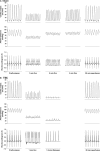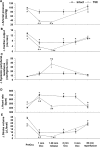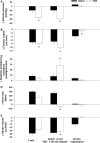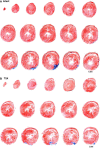Fundamental hemodynamic mechanisms mediating the response to myocardial ischemia in conscious paraplegic mice: cardiac output versus peripheral resistance
- PMID: 28336819
- PMCID: PMC5371571
- DOI: 10.14814/phy2.13214
Fundamental hemodynamic mechanisms mediating the response to myocardial ischemia in conscious paraplegic mice: cardiac output versus peripheral resistance
Abstract
Autonomic dysfunction, a relative sedentary lifestyle, a reduced muscle mass and increased adiposity leads to metabolic abnormalities that accelerate the development of coronary artery disease (CAD) in individuals living with spinal cord injury (SCI). An untoward cardiac incident is related to the degree of CAD, suggesting that the occurrence of a significant cardiac event is significantly higher for individuals with SCI Thus, understanding the fundamental hemodynamic mechanisms mediating the response to myocardial ischemia has the potential to positively impact individuals and families living with SCI Accordingly, we systematically investigated if thoracic level 5 spinal cord transection (T5X; paraplegia) alters the arterial blood pressure response to coronary artery occlusion and if the different arterial blood pressure responses to coronary artery occlusion between intact and paraplegic mice are mediated by changes in cardiac output and or systemic peripheral resistance and whether differences in cardiac output are caused by changes in heart rate and or stroke volume. To achieve this goal, the tolerance to 3 min of coronary artery occlusion was determined in conscious intact and paraplegic mice. Paraplegic mice had an impaired ability to maintain arterial blood pressure during coronary artery occlusion as arterial pressure fell to near lethal levels by 1.38 ± 0.64 min. The lower arterial pressure was mediated by a lower cardiac output as systemic peripheral resistance was elevated in paraplegic mice. The lower cardiac output was mediated by a reduced heart rate and stroke volume. These results indicate that in paraplegic mice, the arterial pressure response to coronary artery occlusion is hemodynamically mediated primarily by cardiac output which is determined by heart rate and stroke volume.
Keywords: Coronary artery disease; myocardial ischemia; spinal reflex.
© 2017 The Authors. Physiological Reports published by Wiley Periodicals, Inc. on behalf of The Physiological Society and the American Physiological Society.
Figures




References
-
- Arnold, J. M. , Feng Q. P., Delaney G. A., and Teasell R. W.. 1995. Autonomic dysreflexia in tetraplegic patients: evidence for alpha‐adrenoceptor hyper‐responsiveness. Clin. Auton. Res. 5:267–270. - PubMed
-
- Bauman, W. , and Spungen A.. 2007. Risk assessment for coronary heart disease in a veteran population with spinal cord injury. Top. Spinal. Cord. Inj. Rehab. 12:35–53.
-
- Bauman, W. A. , and Spungen A. M.. 2008. Coronary heart disease in individuals with spinal cord injury: assessment of risk factors. Spinal Cord 46:466–476. - PubMed
MeSH terms
Grants and funding
LinkOut - more resources
Full Text Sources
Other Literature Sources
Miscellaneous

